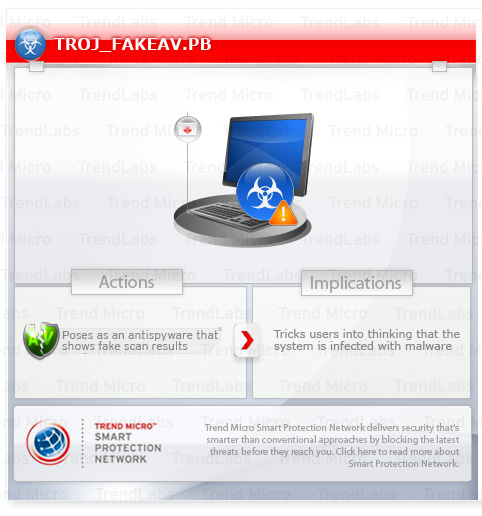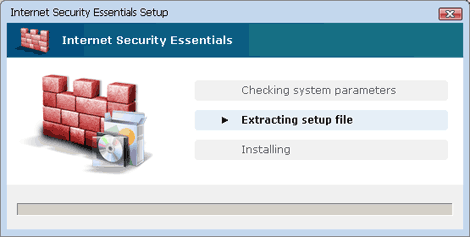TROJ_FAKEAV.PB
Windows 2000, Windows XP, Windows Server 2003


Threat Type: Trojan
Destructiveness: No
Encrypted: Yes
In the wild: Yes
OVERVIEW
This Trojan is noteworthy as it may arrive via blackhat search engine optimization (SEO) poisoned results. More specifically, users may inadvertently download this rogue antivirus program when using search engines to find information on the Japan earthquake.
To get a one-glance comprehensive view of the behavior of this Trojan, refer to the Threat Diagram shown below.

It connects to websites to download and execute a malicious file also detected as TROJ_FAKEAV.PB.
This Trojan may be unknowingly downloaded by a user while visiting malicious websites.
It displays fake alerts that warn users of infection. It also displays fake scanning results of the affected system. It then asks for users to purchase it once scanning is completed. If users decide to purchase the rogue product, users are directed to a certain website asking for sensitive information, such as credit card numbers.
TECHNICAL DETAILS
565,248 bytes
PE
Yes
11 Mar 2011
Downloads files, Displays fake alerts
Arrival Details
This Trojan may be unknowingly downloaded by a user while visiting malicious websites.
Download Routine
This Trojan connects to the following website(s) to download and execute a malicious file:
- {BLOCKED}.{BLOCKED}.67.95
- {BLOCKED}.{BLOCKED}.179.42
- {BLOCKED}r-plerkslot113.net
It saves the files it downloads using the following names:
- %Application Data%\{random characters}\{random file name}.exe - also detected as TROJ_FAKEAV.PB
(Note: %Application Data% is the current user's Application Data folder, which is usually C:\Windows\Profiles\{user name}\Application Data on Windows 98 and ME, C:\WINNT\Profiles\{user name}\Application Data on Windows NT, and C:\Documents and Settings\{user name}\Local Settings\Application Data on Windows 2000, XP, and Server 2003.)
Other Details
This Trojan does the following:
- Displays the following image:

Rogue Antivirus Routine
This Trojan displays fake alerts that warn users of infection. It also displays fake scanning results of the affected system. It then asks for users to purchase it once scanning is completed. If users decide to purchase the rogue product, users are directed to a certain website asking for sensitive information, such as credit card numbers.
NOTES:
It adds the following registry entries to enable the automatic execution of the downloaded file:
HKEY_CURRENT_USER\Software\Microsoft\Windows\CurrentVersion\Run
ISE = "%Application Data%\{random characters}\{random file name}.exe"
However, due the error in the code of the downloaded file, it fails to perform its intended routine.
SOLUTION
8.900
7.890.13
11 Mar 2011
7.893.00
11 Mar 2011
Step 1
For Windows XP and Windows Server 2003 users, before doing any scans, please make sure you disable System Restore to allow full scanning of your computer.
Step 2
Identify and terminate files detected as TROJ_FAKEAV.PB
- If the detected file is displayed in either Windows Task Manager or Process Explorer but you cannot delete it, restart your computer in safe mode. To do this, refer to this link for the complete steps.
- If the detected file is not displayed in either Windows Task Manager or Process Explorer, continue doing the next steps.
Step 3
Delete this registry value
Important: Editing the Windows Registry incorrectly can lead to irreversible system malfunction. Please do this step only if you know how or you can ask assistance from your system administrator. Else, check this Microsoft article first before modifying your computer's registry.
- In HKEY_CURRENT_USER\Software\Microsoft\Windows\CurrentVersion\Run
- ISE = %Application Data%\{random characters}\{random file name}.exe
Step 4
Search and delete these files
- %Application Data%\{random characters}\{random file name}.exe
Step 5
Scan your computer with your Trend Micro product to delete files detected as TROJ_FAKEAV.PB. If the detected files have already been cleaned, deleted, or quarantined by your Trend Micro product, no further step is required. You may opt to simply delete the quarantined files. Please check this Knowledge Base page for more information.
Did this description help? Tell us how we did.

